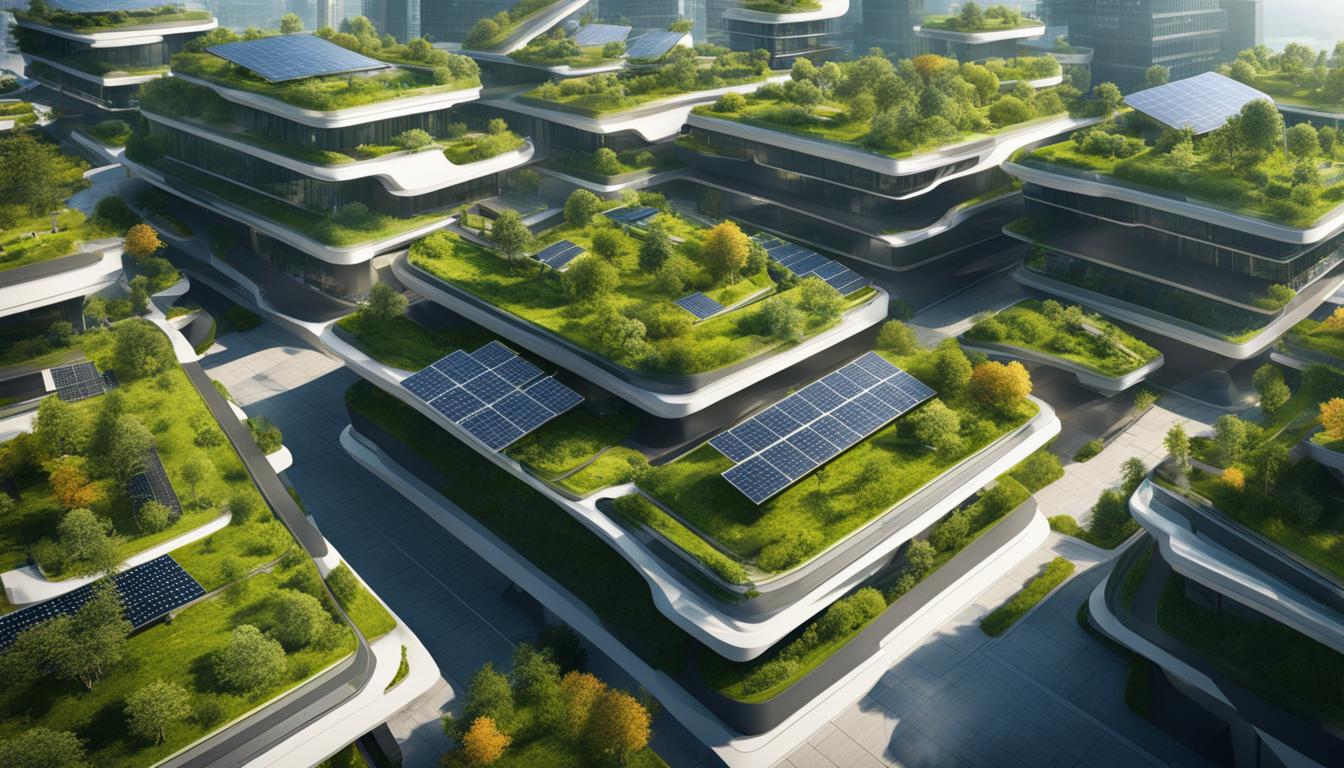Net-zero energy buildings are revolutionizing the field of green building and architecture by offering a sustainable solution for a more environmentally friendly future. With a focus on sustainable construction, eco-friendly design, and the use of green building materials, these innovative structures are leading the way in creating a built environment that embraces sustainability and energy efficiency.
Net-zero energy buildings are designed to consume as little energy as possible while also producing enough renewable energy to meet or exceed their energy needs. By incorporating energy-efficient technologies and renewable energy systems, these buildings significantly reduce energy consumption, minimize environmental impact, and create healthier living and working spaces.
As the demand for sustainable construction grows, net-zero energy buildings are becoming increasingly prevalent. Architects and designers are embracing the challenge of creating buildings that are not only visually appealing but also environmentally responsible. By utilizing innovative design strategies and integrating renewable energy technologies, these buildings are leading the way towards a greener future.
- Net-zero energy buildings offer a sustainable solution for the future of green building and architecture.
- These buildings focus on eco-friendly design, sustainable construction materials, and energy-efficient strategies.
- Advantages of net-zero energy buildings include enhanced energy efficiency, reduced environmental impact, and improved occupant comfort.
- Renewable energy plays a crucial role in achieving net-zero energy in buildings, with technologies such as solar panels and wind turbines being commonly used.
- A comprehensive approach combining sustainable design principles, energy-efficient technologies, and effective energy management strategies is necessary to achieve net-zero energy.
Advantages of Net-Zero Energy Buildings
Net-zero energy buildings offer a multitude of advantages, making them an attractive and sustainable solution for the built environment. These energy-efficient buildings are designed to minimize energy consumption while maximizing renewable energy generation, resulting in enhanced energy efficiency, reduced environmental impact, and improved occupant comfort.
One of the key advantages of net-zero energy buildings is their superior energy efficiency. By incorporating advanced technologies and passive design strategies, such as efficient insulation, energy-efficient appliances, and optimized heating, ventilation, and air conditioning (HVAC) systems, these buildings significantly reduce energy consumption. This not only lowers energy costs but also contributes to the conservation of valuable resources.

Another renewable energy technology widely used in net-zero energy buildings is wind turbines. These turbines harness the power of the wind to generate electricity, offering a sustainable and renewable energy source. By strategically placing wind turbines in areas with ample wind resources, net-zero energy buildings can further augment their renewable energy generation capacity, powering various electrical appliances and systems within the building.
Geothermal heat pumps are also an integral part of the renewable energy integration in net-zero energy buildings. These advanced systems utilize the Earth’s natural heat to provide heating, cooling, and ventilation within a building. By leveraging the constant and renewable thermal energy from the ground, geothermal heat pumps can significantly reduce the energy consumption of traditional HVAC systems, contributing to the overall energy efficiency and sustainability of net-zero energy buildings.
By integrating solar panels, wind turbines, and geothermal heat pumps into net-zero energy buildings, a comprehensive renewable energy system is established. This system allows the buildings to generate their electricity, heating, cooling, and ventilation needs from clean and renewable sources, minimizing their carbon footprint and promoting sustainable practices.
Advantages of Renewable Energy Integration in Net-Zero Energy Buildings
The integration of renewable energy technologies in net-zero energy buildings offers several advantages:
- Reduced reliance on non-renewable energy sources: By generating their energy from renewable sources, net-zero energy buildings can decrease their dependence on fossil fuels and contribute to a more sustainable energy future.
- Lower energy costs: The use of clean and renewable energy sources can help offset the electricity expenses of net-zero energy buildings, reducing overall operating costs.
- Environmental benefits: Renewable energy integration in net-zero energy buildings significantly reduces greenhouse gas emissions and air pollution, leading to a healthier and cleaner environment.
- Increased energy independence: Net-zero energy buildings with renewable energy systems are less vulnerable to fluctuations in energy prices and supply, providing greater energy security and independence.
The integration of renewable energy technologies is a crucial step towards achieving net-zero energy in buildings. By harnessing the power of the sun, wind, and Earth’s natural heat, net-zero energy buildings can operate sustainably, minimize their environmental impact, and pave the way for a greener and more sustainable future.
The Path to Net-Zero Energy Buildings
Achieving net-zero energy in buildings requires a comprehensive approach that combines sustainable design principles, energy-efficient technologies, and effective energy management strategies.
Building certifications, such as LEED (Leadership in Energy and Environmental Design), provide guidelines and standards for designing and constructing energy-efficient buildings. LEED certification is recognized globally as a symbol of sustainability and showcases a commitment to environmental responsibility.
Energy-efficient design is a key component of net-zero energy buildings. By maximizing insulation, incorporating efficient heating and cooling systems, and optimizing natural lighting, these buildings minimize energy consumption and reduce the need for artificial lighting and mechanical ventilation.
Energy monitoring systems play a vital role in tracking and analyzing energy usage within net-zero energy buildings. These systems enable building owners and occupants to monitor real-time energy consumption, identify areas of inefficiency, and make informed decisions to optimize energy use.
Effective energy management strategies are essential for the efficient operation of net-zero energy buildings. Implementing demand response programs allows buildings to adjust energy use based on demand and minimize peak energy consumption. Energy conservation measures, such as occupant education programs and efficient equipment maintenance, further enhance energy efficiency and reduce wastage.
By integrating LEED certification, energy-efficient design, energy monitoring systems, and energy management strategies, buildings can embark on the path toward achieving net-zero energy. Sustainable practices and technologies combined with effective energy management are instrumental in creating a built environment that is environmentally responsible and energy-efficient.
| Benefits of LEED Certification | Energy-Efficient Design Strategies | Key Energy Monitoring Systems | Effective Energy Management Strategies |
|---|---|---|---|
|
|
|
|
Conclusion
Net-zero energy buildings are paving the way for sustainable living and redefining the future of green building and architecture. These innovative structures offer a solution that not only reduces energy consumption but also minimizes environmental impact, creating healthier and more comfortable living and working spaces.
With advancements in renewable energy technologies and a growing awareness of the importance of sustainable design, net-zero energy buildings are becoming increasingly feasible and accessible. As we strive to create a greener and more sustainable future, these cutting-edge buildings will play a crucial role in shaping the future of architecture and the built environment.
By embracing the concept of net-zero energy, we can achieve a harmonious balance between human needs and environmental preservation. These buildings provide a tangible example of how sustainable living and green building practices can go hand in hand, creating a better future for generations to come.
FAQ
What is a net-zero energy building?
A net-zero energy building is designed and built to consume as little energy as possible and produce enough renewable energy to meet or exceed its energy needs. These buildings focus on eco-friendly design, sustainable construction materials, and energy-efficient strategies to create a more sustainable and environmentally friendly built environment.
What are the advantages of net-zero energy buildings?
Net-zero energy buildings offer enhanced energy efficiency, reduced environmental impact, and improved occupant comfort. They incorporate technologies like green roof technology and passive design strategies to minimize energy consumption and maximize renewable energy generation. These buildings can significantly reduce energy costs, minimize greenhouse gas emissions, and create healthier and more sustainable living and working environments.
How does renewable energy play a role in net-zero energy buildings?
Renewable energy technologies, such as solar panels, wind turbines, and geothermal heat pumps, are integrated into net-zero energy buildings to generate clean and renewable energy on-site. These technologies harness the power of the sun, wind, and Earth’s natural heat to produce electricity and provide heating, cooling, and ventilation systems. By utilizing renewable energy, net-zero energy buildings minimize reliance on non-renewable energy sources and operate sustainably with minimal environmental impact.
What is the path to achieving net-zero energy in buildings?
Achieving net-zero energy in buildings requires a comprehensive approach that combines sustainable design principles, energy-efficient technologies, and effective energy management strategies. Building certifications like LEED provide guidelines for designing energy-efficient buildings. Energy monitoring systems and energy management strategies, such as demand response programs and energy conservation measures, help optimize energy use and ensure the efficient operation of net-zero energy buildings.
Why are net-zero energy buildings important for the future of green building and architecture?
Net-zero energy buildings represent the future of sustainable living and the evolution of green building and architecture. These buildings offer a sustainable solution to reduce energy consumption, minimize environmental impact, and create healthier and more comfortable living and working spaces. With advancements in renewable energy technologies and increased awareness of the importance of sustainable design, net-zero energy buildings are becoming more feasible and accessible, playing a crucial role in shaping the future of architecture and the built environment.
Source Links
- https://www.energy.gov/eere/buildings/zero-energy-buildings-resource-hub
- https://en.wikipedia.org/wiki/Zero-energy_building
- https://www.wbdg.org/resources/net-zero-energy-buildings
- Regulatory and Compliance: Pioneering the Future of Saudi Arabia’s Dedicated Cargo Airline - December 21, 2024
- Financial Strategies: Fueling the Growth of Saudi Arabia’s Dedicated Cargo Airline - December 20, 2024
- Operational Excellence: Ensuring Competitive Edge for Saudi Arabia’s Dedicated Cargo Airline - December 19, 2024






